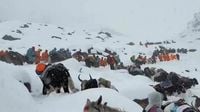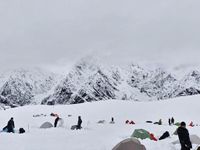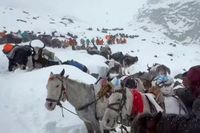As the sun set behind the towering peaks of the Himalayas on Tuesday, October 7, 2025, relief swept through the Karma Valley in Tibet. Nearly 900 hikers, local guides, and yak herders—stranded by a ferocious snowstorm on the eastern face of Mount Everest—had finally reached safety, capping off one of the largest and most complex search-and-rescue operations the region has ever seen.
The ordeal began on the night of Saturday, October 4, when an unusually powerful blizzard swept through the area. The storm dumped heavy snow across the valley, cutting off access to the campsites where hundreds of trekkers were staying at altitudes exceeding 4,900 meters (16,000 feet), according to Xinhua and the Associated Press. The blizzard intensified over the weekend, catching even experienced mountain guides off guard. October, usually a season of clear skies and mild weather, had turned treacherous in a matter of hours—"not normal," as one trekker, Chen Geshuang, put it to Reuters.
By Sunday, as snow continued to fall relentlessly, about 350 hikers managed to descend from the valley, guided by local rescuers and volunteers. The remaining trekkers—some 200 in all—were stranded in deep snow and freezing temperatures, many showing signs of hypothermia. "We were too scared to sleep," one Chinese trekker told Reuters, describing how snow piled up around their tents, forcing them to clear it every 90 minutes just to avoid being buried. Another hiker, Eric Wen, recounted to Reuters that he and his group trudged through 19 kilometers (12 miles) of heavy snow, following the footprints left by those ahead. "Otherwise, it would’ve been impossible for us to make it out on our own," he said.
Rescue teams—composed of police, firefighters, and hundreds of local Tibetan volunteers—mobilized quickly, bringing with them food, medicine, oxygen, and heating equipment. According to BBC, a final group of around a dozen hikers was escorted to a rendezvous point equipped with emergency supplies before making the last leg of the journey to safety. The scale of the operation was immense, with villagers—many worried about their own children on the mountain—joining the efforts with oxen and horses to reach those trapped, as reported by NPR.
In total, 580 hikers and more than 300 local guides, yak herders, and support staff were rescued by late Tuesday, state media confirmed. The trekkers arrived in Qudeng township and surrounding areas of Dingri county, where local officials began organizing their return home "in an orderly manner," according to Xinhua. The Mount Everest scenic area in China's Tibet region, including the Karma and Rongshar valleys and the nearby Cho Oyu peak, was temporarily closed to the public as a precaution.
The timing of the disaster was particularly fraught. The snowstorm struck during China's eight-day "Golden Week" holiday, which began on October 1 and commemorates the anniversary of Communist Party rule in China. This annual holiday is a peak period for tourism, and the Everest region—already drawing a record 540,000 visitors last year—was bustling with outdoor enthusiasts eager to experience the Himalayas. But as the storm unfolded, Chinese social media erupted in criticism. Many users on WeChat and Douyin questioned whether the stranded trekkers should be held financially responsible for the costly rescue, with some dismissing the adventure as a "frivolous pastime by the wealthy in a dangerous area," as AFP reported. One Douyin user wryly remarked, "Even when I have enough money, I still want to bury myself at the foot of Mount Everest."
For those on the mountain, the storm was no laughing matter. Several hikers developed hypothermia, despite being well-equipped for cold weather. Dong Shuchang, a 27-year-old trekker who had visited the Himalayas more than a dozen times, told the BBC he had "never experienced weather like this." Chen Geshuang described the snow as about a meter deep when her group began their retreat on Sunday. "All of us are experienced hikers," she said. "But this blizzard was still extremely difficult to deal with. I was so lucky to get out." Some, like the husband of one woman interviewed by the BBC, barely slept, afraid their tents would collapse under the accumulating snow.
The blizzard’s impact was felt far beyond the Karma Valley. In neighboring Nepal, a South Korean climber died in a weekend storm near the summit of Mera Peak, a 6,476-meter (21,250-foot) Himalayan mountain south of Everest, according to AP. Torrential rains in Nepal also triggered flooding and landslides, killing more than 50 people. Elsewhere in western China, early-season snowstorms battered the provinces of Qinghai, Xinjiang, and Gansu. In Qinghai, more than 200 people were evacuated from a remote valley in the Qilian Mountains, and one person died of hypothermia and altitude sickness, as state media reported. Authorities later warned against entering undeveloped areas without permission, citing the harsh terrain and unpredictable weather. In Xinjiang, the Kanas scenic area was closed after a snowstorm stranded motorists on a nearby highway, though the road was cleared by Monday.
For the Everest region, the storm has raised fresh questions about the risks of adventure tourism and the growing popularity of lesser-known routes like Karma Valley. First explored by Western travelers a century ago, Karma Valley is more pristine and less developed than the well-trodden north face of Everest, which has road access. As climate change makes weather patterns in the Himalayas increasingly unpredictable, both trekkers and the Sherpa communities who support them face mounting hazards. In Nepal, Sherpas have had to adapt to these shifting conditions, which can turn a routine trek into a life-or-death struggle in a matter of hours.
Despite the harrowing experience, the rescue operation has been hailed as a testament to the resilience and solidarity of the local communities, guides, and volunteers who risked their own safety to bring everyone home. As the region recovers and officials assess how to prevent future tragedies, the story of the 900 rescued from the shadow of Everest stands as both a cautionary tale and a reminder of the awe-inspiring—if sometimes perilous—power of nature in the world’s highest mountains.



